County of Nassau
(Princely) County of Nassau Principalities of Nassau (Gefürsteter) Grafschaft Nassau (German) Fürstentümer Nassau (German) | |||||||||
|---|---|---|---|---|---|---|---|---|---|
| 1125–1806 | |||||||||
 Coat of arms
| |||||||||
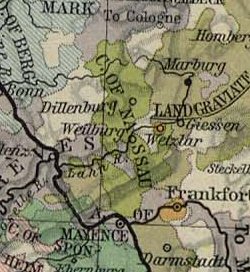 County of Nassau in 1547 | |||||||||
| Status | County | ||||||||
| Capital | Nassau | ||||||||
| Common languages | German (Rhine Franconian dialects, Moselle Franconian dialects) | ||||||||
| Government | County | ||||||||
| Historical era | Middle Ages | ||||||||
• City founded | 915 | ||||||||
• Rupert I claims title of count | 1125 | ||||||||
• Comital title acknowledged | 1159 | ||||||||
• Partitioned multiple times | 1255–1806 | ||||||||
• Remaining parts unified to form duchy | 1806 | ||||||||
| |||||||||
| Today part of | Germany | ||||||||
The County of Nassau was a German state within the Holy Roman Empire and later part of the German Confederation. Its ruling dynasty, the male line of which is now extinct, was the House of Nassau.
Origins[]
Nassau, originally a county, developed on the lower Lahn river in what is known today as Rhineland-Palatinate. The town of Nassau was founded in 915.[1] Dudo of Laurenburg held Nassau as a fiefdom as granted by the Bishopric of Worms. His son, Rupert, built the Nassau Castle there around 1125, declaring himself "Count of Nassau". This title was not officially acknowledged by the Bishop of Worms until 1159 under the rule of Rupert's son, Walram. By 1159, the County of Nassau effectively claimed rights of taxation, toll collection, and justice, at which point it can be considered to become a state.[1]
The Nassauers held the territory between the Taunus and the Westerwald at the lower and middle Lahn. By 1128, they acquired the bailiwick of the Bishopric of Worms, which had numerous rights in the area, and thus created a link between their heritage at the lower Lahn and their possessions near Siegen. In the middle of the 12th century, this relationship was strengthened by the acquisition of parts of the Hesse-Thüringen feudal kingdom, namely the Herborner Mark, the Kalenberger Zent and the Court of Heimau (Löhnberg). Closely linked to this was the "Lordship of Westerwald", also in Nassau's possession at the time. At the end of the 12th century, the House acquired the Reichshof Wiesbaden, an important base in the southwest.
In 1255, after the Counts of Nassau acquired the estates of Weilburg, the sons of Count Henry II divided Nassau for the first time. Walram II received the county of Nassau-Weilburg. From 1328 on, his younger brother, Otto I, held the estates north of the Lahn river, namely the County of Nassau-Siegen and Nassau-Dillenburg. The boundary line was essentially the Lahn, with Otto receiving the northern part of the county with the cities of Siegen, Dillenburg, Herborn and Haiger and Walram retaining the section south of the river, including the cities of Weilburg and Idstein.
County of Nassau-Weilburg[]
Walram's son Adolf became King of Germany in 1292. His son Count Gerlach abdicated in 1344 and the County was divided under his sons in 1355
- County of Nassau-Weilburg, again divided from 1442 to 1574
- County of Nassau-Saarbrücken (Elder)
- County of Nassau-Weilburg
- County of Nassau-Wiesbaden, again divided from 1480 to 1509
- County of Nassau-Idstein
- County of Nassau-Wiesbaden
fell back to Nassau-Weilburg in 1605
- County of Nassau-Sonnenberg, partitioned among Nassau-Wiesbaden and Nassau-Weilburg in 1405
In 1605, all parts of Nassau-Weilburg were again unified under Count Louis II; however, after his death in 1627, his sons divided the county again
- County of Nassau-Idstein, fell to Nassau-Ottweiler in 1721
- County of Nassau-Saarbrücken (Younger), divided again in 1640
- County of Nassau-Saarbrücken, fell to Nassau-Ottweiler in 1723
- County of Nassau-Ottweiler, fell to Nassau-Usingen in 1728
- County of Nassau-Usingen, Principality in 1688
- County of Nassau-Weilburg (Younger)
After Nassau-Usingen had inherited Nassau-Ottweiler with former Nassau-Idstein and Nassau-Saarbrücken, it was reunified with Nassau-Weilburg and raised to the Duchy of Nassau in 1806.
County of Nassau-Dillenburg[]
After the death of Count Otto I, his county was divided between his sons in 1303:
- County of Nassau-Dillenburg, fell to Nassau-Siegen in 1328
- County of Nassau-Hadamar (Elder), fell to Nassau-Dillenburg in 1394
- County of Nassau-Siegen, called Nassau-Dillenburg from 1328 on, again got divided from 1341 to 1561:
- County of Nassau-Beilstein (Elder)
- County of Nassau-Dillenburg (Elder)–1606)
In 1504, Henry III of Nassau-Dillenburg inherited the County's estates at Breda in the Duchy of Brabant, while his younger brother William became Count of Nassau-Dillenburg in 1516. After the son of Henry III, René of Châlon died in 1544, Count William's eldest son William the Silent became Prince of Orange and Lord of Breda, Stadtholder in the Low Countries from 1559 on. His younger brother, John VI, again reunited all Nassau-Dillenburg possessions in 1561, though the County was again divided after his death in 1606.
- County of Nassau-Hadamar (Younger), Principality in 1650, fell to Nassau-Diez in 1743
- County of Nassau-Siegen, (1607–23), again got divided from 1623 to 1734:
- County of Nassau-Siegen (Protestant), Principality in 1664, became extinct in 1734
- County of Nassau-Siegen (Catholic), Principality, fell to Nassau-Diez in 1743
- County of Nassau-Dillenburg, fell to Nassau-Beilstein in 1620
- County of Nassau-Beilstein (Younger), called Nassau-Dillenburg (Younger) from 1620 on, Principality in 1652, fell to Nassau-Dietz in 1739
- County of Nassau-Dietz, fell to Joachim Murat's Grand Duchy of Berg after the dissolution of the Holy Roman Empire in 1806
The Counts of Nassau-Dietz, descendants of William Frederick were stadtholders of Friesland, Groningen and Drenthe and Princes of Orange from 1702 on. When they lost their Dutch possessions during the Napoleonic Wars, they were compensated with the Principality of Nassau-Orange-Fulda. Though they lost their German possessions in 1806, the House of Orange-Nassau, through female succession, was the reigning house of the Grand Duchy of Luxembourg until 1890 and is still the royal house of the Netherlands.
Rulers[]
House of Nassau[]
Partitions of Nassau under House of Nassau rule[]
| County of Laurenburg/ Nassau (1093-1255) | |||||||||||||||||||||||||||||
 Northern Nassau (Ottonian Line) (1255-1303) |
 Southern Nassau (Walramian Line) (1255-1355) | ||||||||||||||||||||||||||||
| Nassau-Siegen (1st creation) (1303-1328) |
Nassau-Hadamar (1st creation) (1303-1394) | ||||||||||||||||||||||||||||
| Nassau-Beilstein (1343-1561) |
|||||||||||||||||||||||||||||
| Nassau-Sonnenberg (1355-1404) |
|||||||||||||||||||||||||||||
| Nassau-Dillenburg (1303-1739) (Siegen line from 1328) |
Nassau-Weilburg (1355-1806) | ||||||||||||||||||||||||||||
| Nassau-Breda (1403-1544) renamed Orange-Nassau (1st creation, Dillenburg line) (1544-1702) |
Nassau-Wiesbaden-Idstein (1st creation) (1355-1605) (divided 1370-86; 1480-1509; 1554-56; 1564-66) | ||||||||||||||||||||||||||||
| Nassau-Saarbrücken (1st creation) (1429-1574) | |||||||||||||||||||||||||||||
| Nassau-Siegen (2nd creation) (1606-1734) (In 1623 divided in Catholic and Protestant ruling lines) |
|||||||||||||||||||||||||||||
| Nassau-Hadamar (2nd creation) (1620-1711) | |||||||||||||||||||||||||||||
| Nassau-Idstein (2nd creation) (1627-1721) | |||||||||||||||||||||||||||||
| Nassau-Ottweiler (1659-1721) |
|||||||||||||||||||||||||||||
| Nassau-Dietz (1606-1702) renamed Orange-Nassau (2nd creation, Dietz line) (1702-1806) |
Nassau-Saarbrücken (2nd creation) (1627-1728) | ||||||||||||||||||||||||||||
| Nassau-Usingen (1659-1806) | |||||||||||||||||||||||||||||
| Nassau-Saarbrücken (3rd creation) (1741-1797) | |||||||||||||||||||||||||||||
| Annexed by France | |||||||||||||||||||||||||||||
| Orange-Nassau (2nd creation, Dietz line) (1813-1815) |
Duchy of Nassau (1806-1866) | ||||||||||||||||||||||||||||
| Annexed by Prussia | |||||||||||||||||||||||||||||
Table of rulers[]
| Ruler | Born | Reign | Death | Ruling part | Consort | Notes | ||
|---|---|---|---|---|---|---|---|---|
| Dudo | ? | 1093-1117 | c.1117 | County of Laurenburg/Nassau | Irmgard/Demudis of Arnstein three children |
Founder of the family and the county. | ||
| Rupert I | c.1090 | 1117-1154 | c.1154 | County of Laurenburg/Nassau | Beatrix of Limburg before 1135 four children |
Sons of Dudo, ruled jointly. Arnold abdicated from the co-regency. | ||
| Arnold I | c.1090 | 1117-1148 | After 1154 | County of Laurenburg/Nassau | Unmarried | |||
| Arnold II | c.1137 | 1154-1159 | c.1159 | County of Laurenburg/Nassau | Unknown at least one child |
Sons of Rupert I, ruled jointly. | ||
| Rupert II | c.1137 | 1154-1159 | c.1159 | County of Laurenburg/Nassau | Beatrix at least two children | |||
| Regent Beatrix of Limburg (1159-60) |
Rupert III the Bellicose | before 1159 | 1159-1191 | 23/28 December 1191 | County of Laurenburg/Nassau | 1169 two children |
Cousins, ruled together. Rupert III, Arnold II's son, co- ruled with Henry I, Rupert II's son. In 1167, with Henry's death he was replaced in the co-regency by his brother Waleran. In 1191, Rupert III's death made his son Herman the new co-regent, but he abdicated the next year. In 1193, Waleran I (then already sole ruler) would become the first legalized Count of Nassau. | |
| Henry I | before 1159 | 1159-1167 | August 1167 | County of Laurenburg/Nassau | Unmarried | |||
| Waleran I | c.1146 | 1167-1198 | 1 February 1198 | County of Laurenburg/Nassau | before 1135 four children | |||
| Herman | ? | 1191-1192 | After 1206 | County of Laurenburg/Nassau | Unmarried | |||
| Henry II the Rich | c.1180 | 1198-1251 | 26 April 1251 | County of Nassau | Matilda of Guelders before 1221 eleven children |
Sons of Waleran I, ruled together. | ||
| Rupert IV | c.1180 | 1198-1230 | c.1239 | County of Nassau | c. 11 December 1215 no children | |||
| Henry II's sons, Waleran II and Otto I, who were ruling together, split the Nassau possessions on 17 December 1255, by a treaty called Prima divisio, which determined the Lahn river as border of the two halves: to the south, called Southern Nassau, was ruled by Waleran and his descendants, who became known as the Walramian Line, which became important in the County of Nassau and Luxembourg; to the north, called Northern Nassau the county was ruled by Otto and his descendants, who became known as the Ottonian Line, which would inherit parts of Nassau, France and the Netherlands. | ||||||||
| Otto I | c.1220 | 1251-1255 | between 3 May 1289 and 19 March 1290 | County of Nassau | Agnes of Leiningen five children |
Son of Henry II, received the land to the north of Lahn river. | ||
| 1255-1289/90 | Northern Nassau | |||||||
| Waleran II | c.1220 | 1251-1255 | 24 January 1276 | County of Nassau | before 1250 seven children |
Son of Henry II, received the land to the south of Lahn river. | ||
| 1255-1276 | Southern Nassau | |||||||
| Adolph I |  |
c.1255 | 1276-1298 | 2 July 1298 | Southern Nassau | Imagina of Isenburg-Limburg 1270 eight children |
In 1292 was crowned King of Germany. | |
| Emicho I | before 1289 | 1289/90-1303 | 7 June 1334 | Northern Nassau | before 1297 eight children |
Sons of Otto I, ruled together until 1303, when they divided the land: Henry received Nassau-Siegen, Emicho received Nassau-Hadamar and John received Nassau-Dillenburg. However, after the childless death of John, Nassau-Dillenburg fell to Nassau-Siegen, which adopted the name Nassau-Dillenburg (named in this table as Nassau-Siegen-Dillenburg). Siegen and Dillenburg were united until 1606. | ||
| 1303-1334 | Nassau-Hadamar | |||||||
| John I | c.1290 | 1289/90-1303 | 10 August 1328 | Northern Nassau | Unmarried | |||
| 1303-1328 | Nassau-Dillenburg | |||||||
| Henry I | 
|
before 1288 | 1289/90-1303 | July/August 1343 | Northern Nassau | 1302 five children | ||
| 1303-1328 | Nassau-Siegen | |||||||
| 1328-1343 | Nassau-Dillenburg | |||||||
| Nassau-Dillenburg was annexed to Nassau-Siegen, which adopted the name Nassau-Dillenburg | ||||||||
| c.1280 | 1298-1304 | 2 November 1304 | Southern Nassau | Unmarried | Left no descendants. He was succeeded by his brother, Gerlach. | |||
| Gerlach I | 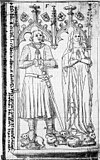 |
c.1285 | 1304-1355 | 7 January 1361 | Southern Nassau | 1307 seven children before 4 January 1337 two children |
Brothers of Rupert V, ruled jointly for a brief period (1312-1316). In 1355 Gerlach abdicated to his sons, who divided the land. | |
| c.1294 | 1312-1316 | 22 December 1324 | Southern Nassau | Unmarried | ||||
| after 1302 | 1334-1365 | 20 January 1365 | Nassau-Hadamar | 1331 ten children |
Sons of Emicho I, ruled jointly. | |||
| after 1302 | 1334-1359 | 1 March 1359 | Nassau-Hadamar | Unmarried | ||||
| Otto II |  |
c.1305 | 1343-1351 | 6 January 1351 | Nassau-Dillenburg | 23 December 1331 four children |
||
| Henry I | 11 June 1323 | 1343-1378 | 28 October 1378 | Nassau-Beilstein | 1339 three children |
Son of Henry I of Nassau-Dillenburg, inherited Beilstein, partitioned from Nassau-Siegen-Dillenburg. | ||
| John I | c.1340 | 1351-1416 | 4 September 1416 | Nassau-Dillenburg | 30 November 1357 six children |
Inherited Vianden. | ||
| c.1340 | 1355-1356 | 1356 | Nassau-Sonnenberg | Unmarried | Son of Gerlach I, inherited Sonnenberg. Died with no descendants. He was succeeded by his brother Rupert. | |||
| John I | c.1309 | 1355-1371 | 20 September 1371 | Nassau-Weilburg | 1333 one child 1353 seven children |
Son of Gerlach I, inherited Weilburg. | ||
| Adolph I |  |
c.1307 | 1355-1370 | 17 January 1370 | Nassau-Idstein | 1322 fourteen children |
Son of Gerlach I, inherited Idstein. | |
| Rupert the Warrior | c.1340 | 1356-1390 | 4 September 1390 | Nassau-Sonnenberg | 1362 no children |
Died with no descendants. Left his inheritance to his widow. | ||
| after 1331 | 1365-1368 | 1368 | Nassau-Hadamar | Unmarried | Left no descendants. He was succeeded by his brother. | |||
| after 1331 | 1368-1394 | 1394 | Nassau-Hadamar | Brother of Henry, left no descendants. The land was annexed to Nassau-Dillenburg. | ||||
| Nassau-Hadamar was annexed to Nassau-Dillenburg | ||||||||
| Gerlach II | 1333 | 1370-1386 | 1386 | Nassau-Idstein | c.1360 no children |
Son of Gerlach I, inherited Idstein. | ||
| Waleran IV |  |
1354 | 1370-1386 1386-1393 |
7 November 1393 | Nassau-Wiesbaden Nassau-Wiesbaden-Idstein |
1374 two children |
||
| Regents (1371-81) and Frederick of Blankenheim, Bishop of Strasbourg (1381-82) |
Philip I | 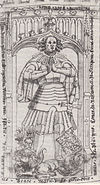 |
1368 | 1371-1429 | 2 July 1429 | Nassau-Weilburg | 1385 one child Elisabeth of Lorraine-Vaudémont 1412 four children |
Divided the land for his sons: the eldest received Nassau-Weilbirg; the youngest, the county of Saarbrücken. |
| Henry II | 29 September 1374 | 1378-1412 | 12 October 1412 | Nassau-Beilstein | 1383 four children |
Sons of Henry I, ruled jointly. | ||
| 1374 | 1378-1414/18 | between 30 December 1414 and 17 April 1418 | Nassau-Beilstein | Unmarried | ||||
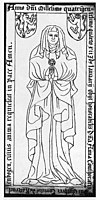 |
? | 1390-1404 | 21 January 1404 | Nassau-Sonnenberg | Rupert, Count of Nassau-Sonnenberg 1362 no children |
Heir of her husband. After her own death, her lands went to Weilburg line. | ||
| Nassau-Sonnenberg was annexed to Nassau-Weilburg | ||||||||
| Adolph II | 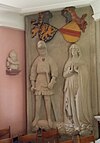 |
1386 | 1393-1426 | 16 July 1426 | Nassau-Wiesbaden-Idstein | March 1418 six children |
||
| After 1383 | 1414/18-1473 | 1473 | Nassau-Beilstein | 1415 four children 1477 one child |
Sons of Henry II, ruled jointly. | |||
| 1418 | 1414/18-1477 | 12 September 1477 | Nassau-Beilstein | Unmarried | ||||
| Adolph I | 1362 | 1388-1420 | 12 June 1420 | Nassau-Dietz | 1376 one child |
Sons of John I, ruled jointly, as Tetrarchs. Counts Adolph and Engelbert inherited via his wives half of Diez and Breda, respectively, which became, after their deaths, part of Nassau patrimony. | ||
| 1416-1420 | Nassau-Dillenburg | |||||||
| John II the Elder | 1365 | 1416-1443 | May 1443 | Nassau-Dillenburg | Unmarried | |||
| Engelbert I | 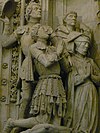
|
1370 | 1403-1442 | 3 May 1442 | Nassau-Breda | Johanna van Polanen 1 August 1403 Breda six children | ||
| 1416-1442 | Nassau-Dillenburg | |||||||
| John III the Younger | 1362 | 1416-1429/30 | 1429/30 | Nassau-Dillenburg | Unmarried | |||
| John II | 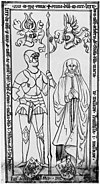 |
1419 | 1426-1480 | 9 May 1480 | Nassau-Wiesbaden-Idstein | 17 June 1437 Breda six children |
||
| Regent Elisabeth of Lorraine-Vaudémont (1429-38) |
Philip II | 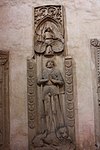 |
12 March 1418 | 1429-1492 | 19 March 1492 | Nassau-Weilburg | 25 September 1440 two children |
Eldest son of Philip I, received Nassau-Weilburg. Between 1464 and 1490, he also served as regent for count John Louis of Nassau-Saarbrücken, together with Duke Eberhard I of Württemberg, following the death of the count's mother and previous regent. |
| John II |  |
4 April 1423 | 1429-1472 | 15 July 1472 | Nassau-Saarbrücken | 30 November 1456 two children 30 October 1470 one child |
Second son of Philip I, received Saarbrücken. | |
| John IV | 
|
1 August 1410 | 1443-1451 | 3 February 1475 | Nassau-Breda | Maria of Loon-Heinsberg 7 February 1440 six children |
Sons of Engelbert I, ruled jointly in Breda and Dillenburg until 1447. In this year they divided their lands: John kept Breda and Henry, Dillenburg. After the latter's death, the former reunited their possessions. | |
| 1443-1447 | Nassau-Dillenburg | |||||||
| 1451-1475 | Nassau-Dillenburg and Nassau-Breda | |||||||
| Henry II | 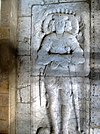
|
7 July 1414 | 1443-1447 | 8 June 1451 | Nassau-Breda | 1435 one child after 1437 no children | ||
| 1443-1451 | Nassau-Dillenburg | |||||||
| Regents (1472-74) Eberhard I, Duke of Württemberg and Philip II, Count of Nassau-Weilburg (1474-90) |
John Louis |  |
19 October 1472 | 1472-1545 | 4 June 1545 | Nassau-Saarbrücken | 29 January 1492 Saarbrücken six children 14 February 1507 nine children |
|
| Engelbert II the Valorious | 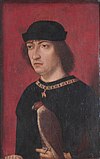 |
17 May 1451 | 1475-1504 | 31 May 1504 | Nassau-Breda | 19 December 1468 Koblenz no children |
Son of John IV. Also Governor of the Habsburg Netherlands. Left no descendants. He was succeeded by his brother. | |
| John V | 9 November 1455 | 1475-1504 1504-1516 |
30 July 1516 | Nassau-Dillenburg Nassau-Dillenburg and Nassau-Breda |
Elisabeth of Hesse-Marburg 11 February 1481 six children |
|||
| 1449 | 1477-1499 | 26 May 1499 | Nassau-Beilstein | 1464 ten children |
||||
| Philip | 1450 | 1480-1509 | 16 June 1509 | Nassau-Idstein | 1470 no children |
|||
| Adolph III | 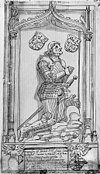 |
10 November 1443 | 1480-1509 1509-1511 |
6 July 1511 | Nassau-Wiesbaden Nassau-Wiesbaden-Idstein |
20 June 1484 four children |
||
| Louis I | 1473 | 1492-1523 | 28 May 1523 | Nassau-Weilburg | 19 April 1501 six children |
|||
| John II | 1475 | 1499-1513 | 18 August 1513 | Nassau-Beilstein | 1492 four children 1510 no children |
|||
| Philip I the Elder | 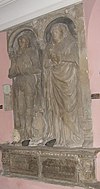 |
26 April 1492 | 1511-1554 | 6 June 1558 | Nassau-Wiesbaden-Idstein | 24 August 1514 Bergen op Zoom six children |
Abdicated for his children, who divided the land once more. | |
| John III | 17 November 1495 | 1513-1561 | 13 December 1561 | Nassau-Beilstein | 1523 no children |
Sons of John II, ruled jointly. They had no descendants and after their death the county was annexed to Nassau-Dillenburg. | ||
| After 1495 | 1513-1525 | 25 February 1525 | Nassau-Beilstein | Unmarried | ||||
| 1479/85 | 1513-1556 | 10 May 1556 | Nassau-Beilstein | Unmarried | Brother of John II, ruled jointly with his nephews. | |||
| Nassau-Beilstein merged again in Nassau-Dillenburg | ||||||||
| Henry III | 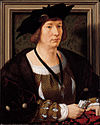 |
12 January 1483 | 1516-1538 | 14 September 1538 | Nassau-Breda | 3 August 1503 no children Claudia of Chalon May 1515 one child Mencía de Mendoza 26 June 1524 one child |
Son of John V, inherited Nassau-Breda. | |
| William I the Rich |  |
10 April 1487 | 1516-1559 | 6 October 1559 | Nassau-Dillenburg | Walburga of Egmont 29 October 1519 Koblenz two children Juliana of Stolberg 29 September 1531 Königstein twelve children |
Son of John V, inherited Nassau-Dillenburg. | |
| Philip III | 20 September 1504 | 1523-1559 | 4 October 1559 | Nassau-Weilburg | 2 March 1523 four children 23 September 1536 one child 17 August 1541 Büdingen three children |
|||
| René | 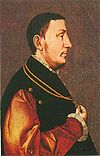 |
5 February 1519 | 1538-1544 | 15 July 1544 | Nassau-Breda and Principality of Orange | Anna of Lorraine 22 August 1540 Bar-le-Duc one child |
Son of Henry III, inherited Nassau-Breda from his father and the Principality of Orange from his mother. Left no descendants, and gave his patrimony to his cousin. | |
| William I the Silent |  |
24 April 1533 | 1544-1584 | 10 July 1584 | Nassau-Breda Orange-Nassau |
Anna van Egmont 8 July 1551 Buren three children Anna of Saxony 24 August 1561 Leipzig (annulled 14 December 1571) five children Charlotte of Bourbon 12 June 1575 Brielle six children Louise de Coligny 12 April 1583 Antwerp one child |
Eldest son of William the Rich, inherited his cousin's lands, and left his father's inheritance to his younger brothers. Murdered in 1584. | |
| Philip II | 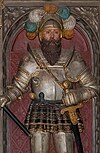 |
25 July 1509 | 1545-1554 | 19 June 1554 | Nassau-Saarbrücken | 17 July 1535 no children |
Left no descendants. He was succeeded by his brother. | |
| John III |  |
5 April 1511 | 1554-1574 | 23 November 1574 | Nassau-Saarbrücken | Unmarried | Left no descendants. The land was absorbed by Nassau-Weilburg. | |
| Nassau-Saarbrücken merged again in Nassau-Weilburg | ||||||||
 |
1518 | 1554-1556 | 5 January 1556 | Nassau-Idstein | Unmarried | Left no descendants. He was succeeded by his brother Philip, who reunited the land. | ||
| Philip II the Younger |  |
1516 | 1554-1556 1556-1564 1564-1566 |
3 January 1566 | Nassau-Wiesbaden Nassau-Wiesbaden-Idstein Nassau-Wiesbaden |
Unmarried | Left no descendants. He was succeeded by his brother Balthasar. | |
| Albert | 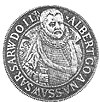 |
26 December 1537 | 1559-1593 | 11 November 1593 | Nassau-Weilburg | Anna of Nassau-Dillenburg 23 September 1536 fourteen children |
Sons of Philip I, ruled jointly. In 1574 annexed Nassau-Saarbrücken | |
| Philip IV |  |
14 October 1542 | 1559-1602 | 12 March 1602 | Nassau-Weilburg | 9 April 1563 one child Elisabeth of Nassau-Dillenburg 3 October 1583 no children | ||
| John VI the Elder |  |
22 November 1536 | 1559-1606 | 8 October 1606 | Nassau-Dillenburg | Elisabeth of Leuchtenberg 6 June 1559 Dillenburg thirteen children 13 September 1580 Dillenburg four children Johannetta of Sayn-Wittgenstein 14 June 1586 Berleburg seven children |
Younger brother of William the Silent, inherited his father's domains, which were divided after his own death. | |
| Balthasar | 1520 | 1564-1566 1566-1568 |
11 January 1568 | Nassau-Idstein Nassau-Wiesbaden-Idstein |
9 June/6 September 1564 one child |
|||
| Regent (1568-87) |
John Louis I | 10 April 1567 | c.1587-1596 | 10 June 1596 | Nassau-Wiesbaden-Idstein | Maria of Nassau-Dillenburg 2 December 1588 Idstein six children |
||
| Philip William | 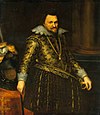 |
19 December 1554 | 1584-1618 | 20 February 1618 | Nassau-Breda Orange-Nassau |
Éléonore de Bourbon 23 November 1606 Fontainebleau no children |
Left no descendants. He was succeeded by his half-brother Maurice. | |
| Regent Maria of Nassau-Dillenburg (1596-1605) |
26 March 1595 | 1596-1599 | 29 August 1599 | Nassau-Wiesbaden-Idstein | Unmarried | Died as minors. After John Louis' death, his lands were annexed to Nassau-Weilburg. | ||
| John Louis II | 21 May 1596 | 1599-1605 | 19 June 1605 | Nassau-Wiesbaden-Idstein | Unmarried | |||
| Nassau-Idstein merged again in Nassau-Weilburg | ||||||||
| Louis II | 9 August 1565 | 1602-1627 | 8 November 1627 | Nassau-Weilburg | Anna Maria of Hesse-Kassel 8 June 1589 Kassel fourteen children |
In 1605 reunited all Southern Nassau. However he divided it again after his death between his sons. | ||
| William Louis | 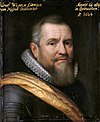 |
13 March 1560 | 1606-1620 | 13 July 1620 | Nassau-Dillenburg | Anna of Orange-Nassau 25 November 1587 Franeker no children |
Son of John VI, received Nassau-Dillenburg. | |
| John VII the Middle | 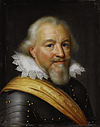 |
7 June 1561 | 1606-1623 | 27 September 1623 | Nassau-Siegen | Magdalena of Waldeck 9 December 1581 Dillenburg twelve children 27 August 1603 Dillenburg thirteen children |
As son of John VI, received Nassau-Siegen. | |
| Ernest Casimir I |  |
22 December 1573 | 1606-1632 | 2 June 1632 | Nassau-Dietz | Sophia Hedwig of Brunswick-Lüneburg 8 June 1607 Dillenburg two children |
Son of John VI, received Nassau-Dietz. | |
| Maurice |  |
14 November 1567 | 1618-1625 | 23 April 1625 | Nassau-Breda Orange-Nassau |
Unmarried | Left no descendants. He was succeeded by his half-brother Frederick Henry. | |
| John Louis |  |
6 August 1590 | 1620-1653 | 10 March 1653 | Nassau-Hadamar | 1617 fourteen children |
Son of John VI, receiving Nassau-Hadamar, which was recreated in 1620, partitioned from Nassau-Dillenburg. | |
| George |  |
1 September 1562 | 1620-1623 | 9 August 1623 | Nassau-Dillenburg | 1584 fourteen children 1605 one child |
Son of John VI, succeeded his childess brother in Nassau-Dillenburg. | |
| John VIII the Younger |  |
29 September 1583 | 1623-1638 | 27 July 1638 | Nassau-Siegen | 13 August 1618 Brussels thirteen children |
Son of John VI, inherited Nassau-Siegen from his brother and co-ruled with his nephew Henry. | |
| Henry II |  |
9 August 1611 | 1623-1652 | 27 October 1652 | Nassau-Siegen | 9 April 1646 four children |
Son of John VII, co-ruled with his uncle. | |
| Louis Henry |  |
9 May 1594 | 1623-1662 | 12 July 1662 | Nassau-Dillenburg | 1615 twelve children 1653 no children 1656 three children |
Sons of George, ruled jointly. | |
| Albert |  |
1 November 1596 | 1623-1626 | 16 June 1626 | Nassau-Dillenburg | Unmarried | ||
| Frederick Henry | 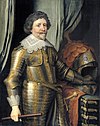 |
29 January 1584 | 1625-1647 | 14 March 1647 | Nassau-Breda Orange-Nassau |
Amalia of Solms-Braunfels 4 April 1625 The Hague nine children |
||
| William Louis | 18 December 1590 | 1627-1640 | 22 August 1640 | Nassau-Saarbrücken | Anna Amalia of Baden-Durlach 25 November 1615 Durlach twelve children |
Son of Louis II, received Nassau-Saarbrücken. | ||
| John |  |
24 November 1603 | 1627-1677 | 23 May 1677 | Nassau-Idstein | 6 June 1629 Strasbourg nine children 6 December 1646 Strasbourg seventeen children |
Son of Louis II, received Nassau-Idstein. From 1675 he also served as regent for Count John Ernest of Nassau-Weilburg. | |
| Ernest Casimir | 15 November 1607 | 1627-1655 | 16 April 1655 | Nassau-Weilburg | 22 February 1634 Weilburg six children |
Son of Louis II, received Nassau-Weilburg. | ||
| Henry Casimir I |  |
21 January 1612 | 1632-1640 | 13 July 1640 | Nassau-Dietz | Unmarried | Left no descendants. He was succeeded by his brother. | |
| John Francis Desideratus |  |
28 July 1627 | 1638-1699 | 17 November 1699 | Nassau-Siegen (Catholic branch) |
14 May 1651 Vienna ten children 31 May 1665 four children 9 February 1669 Brussels ten children |
Catholic, in 1648 John Francis ceded parts of the county to his uncles, who composed the Protestant branch of the family. | |
| William Frederick |  |
7 August 1613 | 1640-1664 | 31 October 1664 | Nassau-Dietz | Albertine Agnes of Orange-Nassau 2 May 1652 Kleve three children |
||
| Crato II | 7 April 1621 | 1640-1642 | 25 July 1642 | Nassau-Saarbrücken | Unmarried | |||
| John Louis | 23 May 1625 | 1642-1659 | 9 February 1690 | Nassau-Saarbrücken | Dorothea Catherine of Palatinate-Birkenfeld-Bischweiler 6 October 1649 Bischweiler eight children |
Son of William Louis, in 1659 divided the land with his other brothers, in which he received Ottweiler. Between 1677 and 1680 he also served as regent for Count John Ernest of Nassau-Weilburg. | ||
| 1659-1690 | Nassau-Ottweiler | |||||||
| William II |  |
27 May 1626 | 1647-1650 | 6 November 1650 | Nassau-Breda Orange-Nassau |
Mary of Great Britain 2 May 1641 London one child |
||
| George Frederick |  |
23 Februy 1606 | 1648-1674 | 5 April 1674 | Nassau-Siegen (Protestant branch) |
Mauritia Eleonora of Portugal 4 June 1647 The Hague no children |
Brother of John VIII, received land from his nephew in 1648. Had no descendants and left his lands to his brother. | |
| Regent Mary of Great Britain (1650-60) Amalia of Solms-Braunfels (1650-72) |
William III |  |
4 November 1650 | 1650-1702 | 8 March 1702 | Nassau-Breda Orange-Nassau |
Mary II, Queen of Great Britain 4 November 1677 London no children |
Became King of England and Scotland (Great Britain) in 1688, jointly with his wife. Left no descendants, and his lands in Nassau and Holland reverted to Nassau-Dietz line. |
| Orange-Nassau annexed to Nassau-Dietz | ||||||||
|
In 1702, the Nassau-Dietz branch followed the House of Orange that had become extinct with William III of England (d. 1702). The counts of Nassau-Dietz not only descended from William the Silent's brother, but in female line also from himself, as William Frederick, Prince of Nassau-Dietz, had married Countess Albertine Agnes of Nassau, the fifth daughter of Frederick Henry, Prince of Orange in 1652. | ||||||||
| Maurice Henry |  |
23 April 1626 | 1653-1679 | 24 January 1679 | Nassau-Hadamar | 30 January 1650 Siegen six children 12 August 1669 Siegen three children 24 October 1675 Hachenburg six children |
||
| Frederick | 26 April 1640 | 1655-1675 | 8 September 1675 | Nassau-Weilburg | 26 May 1663 three children |
|||
| Gustav Adolph |  |
27 March 1632 | 1659-1677 | 9 October 1677 | Nassau-Saarbrücken | 14 June 1662 seven children |
Son of William Louis, after the partition received Saarbrücken. | |
| Waleran |  |
25 February 1635 | 1659-1702 | 17 October 1702 | Nassau-Usingen | 16 June 1678 Mechelen three children 1686 no children |
Son of William Louis, after the partition received Usingen. | |
| Henry |  |
28 August 1641 | 1662-1701 | 18 April 1701 | Nassau-Dillenburg | 13 October 1663 sixteen children |
Grandson of Louis Henry, as son of George Louis, Heir of Nassau-Dillenburg. | |
| Regent Albertine Agnes of Orange-Nassau (1664-77) |
Henry Casimir II |  |
18 January 1657 | 1664-1696 | 25 March 1696 | Nassau-Dietz | Henriëtte Amalia of Anhalt-Dessau 26 November 1683 Dessau nine children |
|
| Regent John, Count of Nassau-Idstein (1675-77) John Louis, Count of Nassau-Ottweiler (1677-80) |
John Ernest |  |
13 June 1664 | 1675-1719 | 27 February 1719 | Nassau-Weilburg | 3 April 1683 nine children |
|
| John Maurice the Brazilian |  |
17 June 1604 | 1674-1679 | 20 December 1679 | Nassau-Siegen (Protestant branch) |
Unmarried | ||
| Louis Crato |  |
28 March 1663 | 1677-1713 | 14 February 1713 | Nassau-Saarbrücken | 25 April 1699 eight children |
Left no male descendants. He was succeeded by his brother Charles Louis. | |
| George August |  |
26 February 1665 | 1677-1721 | 26 October 1721 | Nassau-Idstein | 22 September 1688 Kirchheim unter Teck twelve children |
||
| Nassau-Idstein was annexed by Nassau-Saarbrücken | ||||||||
| Regent (1679-94) |
Francis Alexander |  |
27 January 1674 | 1679-1711 | 27 May 1711 | Nassau-Hadamar | 18 October 1695 Lovosice (annulled 1705) fourteen children |
Left no surviving descendants, and his lands were divided by the neighbouring counties. |
| Nassau-Hadamar divided between Nassau-Dietz, Nassau-Dillenburg and Nassau-Siegen | ||||||||
| William Maurice | 18 January 1649 | 1679-1691 | 23 January 1691 | Nassau-Siegen (Protestant branch) |
6 February 1678 Schaumburg two children |
|||
| Frederick William I | 20 February 1680 | 1691-1722 | 13 February 1722 | Nassau-Siegen (Protestant branch) |
7 January 1702 five children 13 April 1708 eight children |
In 1707, after the deposition of his cousin William Hyacinth, he was able to reunite all Nassau-Siegen. | ||
| Regent Henriëtte Amalia of Anhalt-Dessau (1696-1708) |
John William Friso | 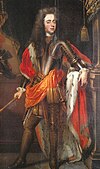 |
14 August 1687 | 1696-1711 | 14 July 1711 | Nassau-Dietz Orange-Nassau |
Marie Louise of Hesse-Kassel 26 April 1709 Kassel two children |
Became Stadholder in Friesland and Groningen, and in 1702 became the heir of William III and thus the founder of the younger House of Orange-Nassau and of the Dutch Royal Family. However, he had to split the Dutch properties with the King of Prussia who also descended from William I. |
| William Hyacinth |  |
3 April 1667 | 1699-1707 | 18 April 1743 | Nassau-Siegen (Catholic branch) |
9 April 1687 Liège three children 22 May 1698 Frankfurt one child 28 July 1740 Vienna no children |
Son of John Francis Desideratus. Mismanaged the government of the principality and was probably deposed in 1707. His Protestant cousin reunited all Nassau-Siegen. | |
| William II | 28 August 1670 | 1701-1724 | 21 September 1724 | Nassau-Dillenburg | 13 January 1699 Harzgerode two children |
Left no surviving descendants. He was succeeded by his brother. | ||
| William Henry |  |
2 May 1684 | 1702-1718 | 14 February 1718 | Nassau-Usingen | Charlotte Amalia of Nassau-Dillenburg 15 April 1706 Dillenburg nine children |
||
| Regent Marie Louise of Hesse-Kassel (1711-29) |
William IV |  |
1 September 1711 | 1711-1751 | 22 October 1751 | Nassau-Dietz Orange-Nassau |
Anne of Great Britain 25 March 1734 London three children |
Inherited a number of Nassau territories besides his paternal Nassau-Dietz, namely Nassau-Hadamar in 1711, Nassau-Siegen in 1734, and Nassau-Dillenburg in 1739. In 1732, Frederick William I of Prussia left him his Dutch properties, including Huis ten Bosch palace and Het Loo Palace. William IV became stadtholder of the Netherlands in 1747 and reunited all of the Dutch and German possessions of his family (except for Nassau-Weilburg) in his hand, styling himself Prince of Orange and Nassau. |
| Charles Louis | 6 January 1665 | 1713-1723 | 6 December 1723 | Nassau-Saarbrücken | Christiane Charlotte of Nassau-Ottweiler 22 April 1713 Saarbrücken two children |
Left no descendants. The land went to his cousin from Nassau-Ottweiler. | ||
| Charles August |  |
17 September 1685 | 1719-1753 | 9 November 1753 | Nassau-Weilburg | 17 August 1723 Wiesbaden seven children |
||
| Regent (1722-26) |
Frederick William II | 11 November 1706 | 1722-1734 | 11 November 1734 | Nassau-Siegen | 23 September 1728 five children |
Left no surviving male descendants. After his death Nassau-Siegen were annexed to Nassau-Dietz. | |
| Nassau-Siegen was annexed by Nassau-Dietz | ||||||||
| Frederick Louis | 
|
13 November 1651 | 1690-1723 | 25 May 1728 | Nassau-Ottweiler | 28 July 1680 eight children Louise Sophie of Hanau-Lichtenberg 27 September 1697 no children |
In 1723 inherited Saarbrücken, reuniting Ottweiler with the newly-inherited land. | |
| 1723-1728 | Nassau-Saarbrücken | |||||||
| Nassau-Ottweiler merged again in Nassau-Saarbrücken | ||||||||
| Christian | 12 August 1688 | 1724-1739 | 28 August 1739 | Nassau-Dillenburg | 1725 no children |
Left no surviving descendants and his lands were annexed to Nassau-Dietz. | ||
| Nassau-Dillenburg was annexed by Nassau-Dietz | ||||||||
| Regent Charlotte Amalia of Nassau-Dillenburg (1718-34) |
Charles | 
|
31 December 1712 | 1718-1741 | 21 June 1775 | Nassau-Usingen and Nassau-Saarbrücken | 26 December 1734 four children after 1740 (morganatic) four children |
In 1741 gave Saarbrücken to his brother, and retained Usingen. |
| 1741-1775 | Nassau-Usingen | |||||||
| William Henry II |  |
6 March 1718 | 1741-1768 | 24 July 1768 | Nassau-Saarbrücken | 28 February 1742 Erbach five children |
Received Nassau-Saarbrücken from his brother. | |
| Regent Anne of Great Britain (1751-59) Marie Louise of Hesse-Kassel (1759-65) Louis Ernest, Duke of Brunswick-Bevern (1759-66) Carolina of Orange-Nassau (1765-66) |
William V |  |
8 March 1748 | 1751-1806 | 9 April 1806 | Nassau-Dietz Orange-Nassau |
Wilhelmina of Prussia I 4 October 1767 Berlin five children |
|
| Charles Christian | 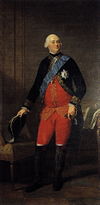 |
16 January 1735 | 1753-1788 | 28 November 1788 | Nassau-Weilburg | Carolina of Orange-Nassau 5 March 1760 The Hague fifteen children 2 October 1788 (morganatic) no children |
||
| Louis |  |
3 January 1745 | 1768-1794 | 2 March 1794 | Nassau-Saarbrücken | 30 October 1766 Schwarzburg one child 30 October 1766 (morganatic, legitimized 1787) seven children |
||
| Charles William |  |
9 November 1735 | 1775-1803 | 17 May 1803 | Nassau-Usingen | Caroline Felizitas of Leiningen-Dagsburg 16 April 1760 one child |
Left no descendants. He was succeeded by his brother. | |
| In 1783, the heads of various branches of the House of Nassau sealed the Nassau Family Pact (Erbverein) to regulate future succession in their states, and to establish a dynastic hierarchy whereby the Prince of Orange-Nassau-Dietz was recognised as President of the House of Nassau.[2] | ||||||||
| Henry Louis | 9 March 1768 | 1794-1797 | 27 April 1797 | Nassau-Saarbrücken | 6 October 1785 no children |
After his death Nassau-Saarbrücken was occupied by France. | ||
| Nassau-Saarbrücken was annexed by France | ||||||||
| Frederick Augustus | 
|
23 April 1738 | 1803-1806 | 24 March 1816 | Nassau-Usingen | 9 June 1775 seven children |
From 1806 ruled jointly. Frederick William retained the title of Prince of Nassau, and Frederick Augustus maintained his title of Duke. | |
| 1806-1816 | Duchy of Nassau | |||||||
| Nassau-Usingen united with Nassau-Weilburg to form the Duchy of Nassau | ||||||||
| Frederick William | 
|
25 October 1768 | 1788-1806 | 9 January 1816 | Nassau-Weilburg | Louise Isabelle of Kirchberg 31 July 1788 Hachenburg four children | ||
| 1806-1816 | Duchy of Nassau | |||||||
| Nassau-Weilburg united with Nassau-Usingen to form the Duchy of Nassau | ||||||||
| William VI |  |
24 August 1772 | 1806 1813-1815 |
12 December 1843 | Nassau-Dietz Orange-Nassau |
Wilhelmina of Prussia II 1 October 1791 Berlin six children Henrietta d'Oultremont 17 February 1841 (morganatic) no children |
Ascended 9 April 1806, and on 27 October his lands were annexed to the Duchy of Nassau. He revived the Principality of Orange-Nassau, but in 1815 was proclaimed King of the Netherlands. His Nassau lands returned to the Duchy of Nassau. See List of monarchs of the Netherlands for the descendants of William. | |
| In 1806, Nassau-Dietz and Orange-Nassau were annexed to the Duchy of Nassau In 1815, Nassau-Dietz and Orange-Nassau were annexed again to the Duchy of Nassau | ||||||||
| William | 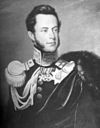 |
14 June 1792 | 1816-1839 | 20/30 August 1839 | Duchy of Nassau | Louise of Saxe-Hildburghausen 24 June 1814 Weilburg eight children Pauline of Württemberg 23 April 1829 Stuttgart four children |
||
| Adolph |  |
24 July 1817 | 1839-1866 | 17 November 1905 | Duchy of Nassau | Elizabeth Mikhailovna of Russia 31 January 1844 St. Petersburg no children Adelheid-Marie of Anhalt-Dessau 23 April 1851 Dessau five children |
In 1866 lost his Nassau lands, but he was granted in 1890 the Grand Duchy of Luxembourg after the death of his cousin without male descendants. See List of monarchs of Luxembourg for the descendants of Adolph. | |
| In 1866, Nassau was annexed to the Kingdom of Prussia | ||||||||
See also[]
- House of Nassau
- County of Nassau-Saarbrücken
- Duchy of Nassau
References[]
- ^ Jump up to: a b Abramson, Scott F. (2017-01-01). "The Economic Origins of the Territorial State". International Organization. 71 (1): 97–130. doi:10.1017/S0020818316000308. ISSN 0020-8183.
- ^ Hay, Mark Edward (1 June 2016). "The House of Nassau between France and Independence, 1795–1814: Lesser Powers, Strategies of Conflict Resolution, Dynastic Networks". The International History Review. 38 (3): 482–504. doi:10.1080/07075332.2015.1046387.
- States of the Confederation of the Rhine
- States of the German Confederation
- Nassau (state)
- Former states and territories of Rhineland-Palatinate
- Counties of the Holy Roman Empire

